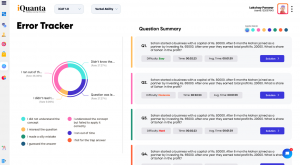CAT Mock Analysis
With around a few months remaining for CAT 2024, we hope everyone has started appearing for CAT Mock Tests already. Mock tests give you a clear picture of the type of questions and difficulty level of the exam. Regularly appearing for mocks helps increase your Speed and Accuracy. While a lot of people appear for mocks, they don’t analyze the results. Appearing for these tests is only fruitful if you analyze your score and thereby work on improving it. CAT mock analysis and building a CAT mock strategy is important as it will help you focus on your weaker areas.

https://youtu.be/kEn88jyZDTU Also Read: 5 Months Strategy to Crack CAT 2024 Here is iQuanta’s step-wise guide for analyzing the mocks:
Step 1: Appear For Tests
 When you have selected which CAT mocks to take, take its complete set because every institute designs its mock test series to cover the whole set of the problems that can be asked. If you have enough time, club it with mocks of other institutes to have more variety and see where you stand in the competition. You can start by taking 1-2 mocks every week as of now. Also Read: Best CAT Mock Test Series with A.I. Based Analysis
When you have selected which CAT mocks to take, take its complete set because every institute designs its mock test series to cover the whole set of the problems that can be asked. If you have enough time, club it with mocks of other institutes to have more variety and see where you stand in the competition. You can start by taking 1-2 mocks every week as of now. Also Read: Best CAT Mock Test Series with A.I. Based Analysis
STEP 2: Build a CAT Mock Strategy
 Building the best CAT mock strategy for oneself is a continuous process till you take a sufficient number of mocks and find what works best for you. As of now, start taking mocks with a fresh mind, don’t exhaust yourself before the test. This would help you realise your full potential.
Building the best CAT mock strategy for oneself is a continuous process till you take a sufficient number of mocks and find what works best for you. As of now, start taking mocks with a fresh mind, don’t exhaust yourself before the test. This would help you realise your full potential.
CAT Mock Strategy – Quants
Prepare for CAT Quant with a comprehensive strategy. Click Here!
Round 1: Go through all the questions and Solve the easiest questions (sitters) there itself, the ones for which you know the solution. Mark for review the questions that you know how to solve but it might take some time or you have an idea about the concept behind it. Round 2: Attempt the marked for review questions. Round 3: (If at all you get to this part) Attempt the unmarked questions
CAT Mock Strategy – VARC
Prepare for CAT VARC section with a comprehensive strategy.
While attempting the VARC section, your CAT mock strategy should be to either start with RCs or VA questions. Pick out the RCs which are familiar to you or topics which you find interesting. While reading an RC your mind should be completely focussed, keeping the note of the central idea, identifying the main points/arguments the author wants and filtering out the redundant information present in the passage. While going through the RC questions, if you are confused between any two options, mark that question for review and move forward. Do not guesstimate at that point of time. If you have time at the end, revisit and try solving again. This section should be allotted at least 30 minutes. VA section should be allotted a maximum of 6-10 minutes because 4-5 out of the total questions are TITA with no negative marking. Want to gain expertise in CAT Parajumbles? Click Here!
CAT Mock Strategy – LRDI
There are two different CAT mock strategies for different type of aspirants: 1) Those who are solving less than 2 sets in a Mock consistently:
- In the first 5-6 minutes, go through the entire 4 sets along with their questions.
- Select 1-2 sets according to the relative difficulty level and use the next 30 minutes to solve them.
- If after trying to solve the question for 5 minutes and going through the data, you cannot solve and get stuck in it, leave the set, ignoring your ego and move forward. Do not waste 20 minutes on a single set.
2) Those who are solving more than 2 sets in a Mock consistently:
- Do not waste your time in selecting sets or categorising them, as these 5-6 minutes could be used to solve 4-5 more questions in the end.
- Once you start the set, take 4 minutes time to make some headway, if you can’t, let go of your ego, go to the next set. Don’t waste your time.
LRDI preparation strategy for CAT exam. Click Here!
STEP 3: CAT 2024 Mock Analysis
 The most important step is the CAT mock analysis. Merely appearing for the mocks will not improve your performance until you don’t analyze your strengths and weaknesses. Spend a day and analyze your result section-wise. Note the time spent on every question, the topics and types of questions that you’re good at and the one’s where you can improve. If you have taken iCAT mocks, you must know about the A.I. Based Error Tracker. The reason why many people get confused on how to analyse mock, which we have made it personalised & tailor made for each taker, where you you’ll have a track of all the type of errors you made, at one place. This will give you details on what type of errors you are making on any particular topic or section. You can moreover select those type of questions, where you are making similar type of errors. For example you can simply select those questions where you are talking more than regular time from each section or topic, and check those questions and solutions. (There will be 3 buttons on which topic you wanna select, which type of error you wanna select, or you wana select skipped ones or correct ones at one place ) You can also check those type of questions where you din’t know the concepts, this will help in focussing on those areas where you need to strengthen the concepts or where you need to increase the speed. Like this there will be 8-10 type of identifiers, in not just those questions where you made error, but also in skipped questions and in correct one’s too.
The most important step is the CAT mock analysis. Merely appearing for the mocks will not improve your performance until you don’t analyze your strengths and weaknesses. Spend a day and analyze your result section-wise. Note the time spent on every question, the topics and types of questions that you’re good at and the one’s where you can improve. If you have taken iCAT mocks, you must know about the A.I. Based Error Tracker. The reason why many people get confused on how to analyse mock, which we have made it personalised & tailor made for each taker, where you you’ll have a track of all the type of errors you made, at one place. This will give you details on what type of errors you are making on any particular topic or section. You can moreover select those type of questions, where you are making similar type of errors. For example you can simply select those questions where you are talking more than regular time from each section or topic, and check those questions and solutions. (There will be 3 buttons on which topic you wanna select, which type of error you wanna select, or you wana select skipped ones or correct ones at one place ) You can also check those type of questions where you din’t know the concepts, this will help in focussing on those areas where you need to strengthen the concepts or where you need to increase the speed. Like this there will be 8-10 type of identifiers, in not just those questions where you made error, but also in skipped questions and in correct one’s too. 
 How Many Mocks To Take Before CAT? Read Here!
How Many Mocks To Take Before CAT? Read Here!
1. CAT Mock Analysis: Quantitative Ability
 The best way to analyse QA is to prepare an excel sheet for every mock. Fill this Excel sheet for every mock, then the CAT mock analysis for your weak and strong points needs to be done in the following manner:
The best way to analyse QA is to prepare an excel sheet for every mock. Fill this Excel sheet for every mock, then the CAT mock analysis for your weak and strong points needs to be done in the following manner:
- Topics where your accuracy is greater than 80% are your strong areas. Work upon these to minimise the time spent on these questions. Since, your basics for these topics are strong, try to attempt maximum number of questions.
- Topics where accuracy is 55 to 75 %, are your improvement areas, basics are strong but these areas require practice.
- Topics where accuracy is less than 50% are your weak areas. You need to work upon these areas as the concepts are not clear.
Solve the question you got wrong once again, find out the mistake, make a note of it and promise yourself to not repeat the mistake again. If it was just a calculation error, it means you need more time based practice.
- While your CAT mock analysis, don’t neglect the answers you got right. People generally ignore the correctly attempted questions. But, getting a question correct is not enough, it’s also important to get it correct in decent time. If you spend 3 or more minutes on one question, it has probably done more harm than good.
- Check if you can find any shortcut (other than the answer booklet) which is easier for you to understand. Post the question in CAT Preparation-iQuanta group, or iQuanta paid doubts group, you’ll probably get a better solution from Indrajeet and iQuanta team.
- After the completion of your CAT mock analysis, practice the questions where you spent too much time and if you are not able to solve similar questions within two minutes, in the next mocks, mark them and move forward. You can always come back, if the time allows.
- Prepare a list of questions that you skipped but should have attempted. Try to solve these in the next mock.
And for the kind of questions where you spent too much time but left it even though you could have attempted it, requires some good amount of practice to get familiar with. For the same you can solve past year CAT questions on these topics followed by topic wise tests from any standard source. You can also solve questions from the repository of iQuanta Practice questions in iQuanta Doubts Group (paid). Apart from this, iQuanta’s iConcept material can also be used for free practice.
2. CAT Mock Analysis: VARC
 Take a deep breath – you have successfully taken your mock. That is always the first step. But taking mocks without analysing them is an idea half-baked. The right CAT mock strategy to follow for CAT mock analysis will be to attempt the paper again, but without the added pressure of a timer. You can keep a tab on your time but don’t be in a rush. Take as much time as you need, understand the passage and then go on and select the answer. You can also select a second option (mark it as Choice 2) for the questions that you were really confused about. Complete the section. While your CAT mock analysis for VARC make sure that you:
Take a deep breath – you have successfully taken your mock. That is always the first step. But taking mocks without analysing them is an idea half-baked. The right CAT mock strategy to follow for CAT mock analysis will be to attempt the paper again, but without the added pressure of a timer. You can keep a tab on your time but don’t be in a rush. Take as much time as you need, understand the passage and then go on and select the answer. You can also select a second option (mark it as Choice 2) for the questions that you were really confused about. Complete the section. While your CAT mock analysis for VARC make sure that you:
- Attempt all the RC’s that you missed the first time. Also, try to categorize the passages – science and technology, economics, philosophy, abstract or just an author’s take on any particular thing. Practice 250 Genre-wise RCs. Click Here!
- Analyze the “TONE” for every RC in the mock test.
- Analyze the reason for the incorrect attempts. Try to understand the author’s point of view and compare it with your own. This will also help in cases of two similar options.
- Note down all the new words in the RCs and find their meanings. This would help you in improving your vocabulary.
- For non-RC questions, the CAT mock strategy would be to categorize the problems into summary, inference, para completion and check where you’ve made maximum number of mistakes and mark the topic which you think requires your attention.
Improvement post VARC CAT mock analysis:
Post your VARC CAT mock analysis, see how much were you able to score without the clock ticking. This was the target score for your specific mock. Analyze to know what kind of questions you got wrong. Get into details; find out the genre of the RC, the type of question (Inference, Assumption, Central Idea, Specific Detail Question etc.) In case you were confused between two options and marked the incorrect options, keep a note of them as well. Read more from the genre you are not comfortable with. Solve more Questions from the specific topic in which you had difficulty and get your doubts cleared by posting in iQuanta Group. If you still are not convinced by the answers, junk it – no point breaking your head over a single question. Just keep Reading, work on the words you had difficulty with in the paper. And lastly, breathe! Enjoy your scores and don’t let one bad mock bring you down and get to the next mock.
3. CAT Mock Analysis: LRDI
![]() Now, coming to the CAT mock analysis for LRDI section, follow these steps: For DI and LR, solve all the sets that you missed or could not solve. Note down the time taken to solve this. You must not take more than 15 minutes to solve a set. Check the new concepts in every mock test and make a list of these new concepts that you missed while covering those topics and practice more such questions. Also, analyze which all sets should have been selected in the test in the priority order also which all should never be selected in the test. Selection of set is the most important part in the mock and its analysis must be done. Big Question : Which set to choose? The answer to this question lies within you. As you keep practicing and solving different kinds of questions, you’ll find your comfort zone. When you start the test, skim through all the sets once in around 3-5 minutes and focus on those in which you feel more confident. It might happen that you start solving a set of your own choice, but are still unable to crack it. Many people take it upon their ego and thus end up wasting a lot of time on such questions. Another possibility is that after spending around 10 unsuccessful minutes on a set, you’d feel that now you have to solve it anyhow as you’ve already given too much time on it. This is a trap and we urge you not to fall into it. In many LR sets, you’ll find a list of information, sometimes going up to more than 10 points. For solving such questions, you need to be very efficient. You’ve to reproduce the question on your sheet of paper while reading itself, using shorthand notations. Make sure that you don’t keep returning to the descriptive part while solving each question. This will save you a lot of time and will also make the process of solving much easier. Many times, you might find yourself clueless in midst of a question, with no idea on how to proceed further with the given information. This is where the CAT mock strategy plays its part. In those moments, you’ve to remember that all the information required for you to solve that particular question is present on your screen. Here, you can act a bit smart and also use the options to solve your question. People sometimes are so immersed in filling up the table at hand, that they forget to look at the questions that follow. It is a good step to check out all the four questions if you ever get stuck. Looking at the options in the questions will give a better idea on how to solve it and also acts as a hint in cases there is a ‘Cannot be determined’ option. Sometimes, you might not be able to solve all 4 questions in a set due to some limitations. In those cases, it’s a good practice to solve 1-2 questions quickly and move on to the next set instead of wasting your time. In the end, if you’re left with 5-7 minutes and it’s too late to start a new set, you can return to these questions and try solving them again.
Now, coming to the CAT mock analysis for LRDI section, follow these steps: For DI and LR, solve all the sets that you missed or could not solve. Note down the time taken to solve this. You must not take more than 15 minutes to solve a set. Check the new concepts in every mock test and make a list of these new concepts that you missed while covering those topics and practice more such questions. Also, analyze which all sets should have been selected in the test in the priority order also which all should never be selected in the test. Selection of set is the most important part in the mock and its analysis must be done. Big Question : Which set to choose? The answer to this question lies within you. As you keep practicing and solving different kinds of questions, you’ll find your comfort zone. When you start the test, skim through all the sets once in around 3-5 minutes and focus on those in which you feel more confident. It might happen that you start solving a set of your own choice, but are still unable to crack it. Many people take it upon their ego and thus end up wasting a lot of time on such questions. Another possibility is that after spending around 10 unsuccessful minutes on a set, you’d feel that now you have to solve it anyhow as you’ve already given too much time on it. This is a trap and we urge you not to fall into it. In many LR sets, you’ll find a list of information, sometimes going up to more than 10 points. For solving such questions, you need to be very efficient. You’ve to reproduce the question on your sheet of paper while reading itself, using shorthand notations. Make sure that you don’t keep returning to the descriptive part while solving each question. This will save you a lot of time and will also make the process of solving much easier. Many times, you might find yourself clueless in midst of a question, with no idea on how to proceed further with the given information. This is where the CAT mock strategy plays its part. In those moments, you’ve to remember that all the information required for you to solve that particular question is present on your screen. Here, you can act a bit smart and also use the options to solve your question. People sometimes are so immersed in filling up the table at hand, that they forget to look at the questions that follow. It is a good step to check out all the four questions if you ever get stuck. Looking at the options in the questions will give a better idea on how to solve it and also acts as a hint in cases there is a ‘Cannot be determined’ option. Sometimes, you might not be able to solve all 4 questions in a set due to some limitations. In those cases, it’s a good practice to solve 1-2 questions quickly and move on to the next set instead of wasting your time. In the end, if you’re left with 5-7 minutes and it’s too late to start a new set, you can return to these questions and try solving them again.
STEP 4: Prepare a Sheet
- (If you do not have iCAT mocks) Once you have completed your CAT mock analysis, make a sheet of the following:
- New quant formulae
- New strategies used in DI-LR
- New grammar rules learnt in VA
- New words and their meanings
- (If you have iCAT mocks) You can check your Analysis dashboard after completing your mock. Check your accuracy, questions attempted, unattempted, correct or incorrect answer along with the level of difficulty mentioned. You can download this report to keep a record.

STEP 5: Take Sectionals
After revision of the weak areas, take sectionals of the weaker sections and topic-wise tests of those you’re weak in before going for the next mock.
STEP 6: Prepare Your Next CAT Mock Strategy
For your next mock, prepare a CAT mock strategy to complete the exam with maximum accuracy. Solve the questions from your strong areas first. Just aim at increasing accuracy, getting maximum right answers in minimum span of time. Be very selective and conservative with your 120 minutes. Don’t waste them on questions that aren’t worth it. Don’t give any question a second more than it deserves. So, pull up your socks and start appearing for all the mocks. This is the best opportunity to take risks and analyze your strengths and weaknesses.
How To Work On Your Weaker Areas For CAT?
Once you are done with the mocks and analysis in iCAT mocks, you’ll be redirected to the iRadar/Goal tracker page. Here, you’ll get a list of B-schools you can crack based on your current mock percentile. Additionally, your weaker areas and corrective mesures will also be highlighted. ![]() After your CAT mock analysis, it is essential that you start working on your weaker areas post analysis. Now, how to ensure betterment in your next mock? You can go for IIM ABC practice batch by iQuanta where you’ll be getting 7500+ CAT level practice questions from all the three sections. The students enrolling in the course will be added to this secret group. A few pointers that I want you to keep in mind before you buy this :
After your CAT mock analysis, it is essential that you start working on your weaker areas post analysis. Now, how to ensure betterment in your next mock? You can go for IIM ABC practice batch by iQuanta where you’ll be getting 7500+ CAT level practice questions from all the three sections. The students enrolling in the course will be added to this secret group. A few pointers that I want you to keep in mind before you buy this :
- You have to dedicate two to three hours everyday for you to get to 99 Percentile. If you cannot take the time out, this exercise is not going to make any sense.
- This course is supposed to be rigorous practice, practice and practice. It is supposed to fill the gap for people who cannot get to a 99.5 %ile.
IIM ABC Batch Details
 To join India’s largest CAT preparation community and for free 24*7 doubt clarification, join the group linked below.
To join India’s largest CAT preparation community and for free 24*7 doubt clarification, join the group linked below. 

